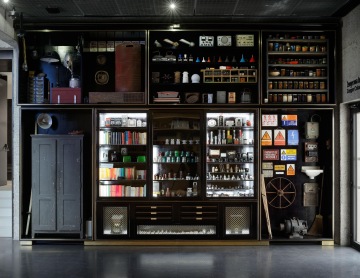Mark Dion: Cabinet of Electrical Curiosities
Mark Dion: Cabinet of Electrical Curiosities
Curator: Christelle Havranek
Using industrial artifacts and everyday objects collected on the former Zenger electrical substation site, Mark Dion’s work tells the story of a unique place, from its construction in the 1930s to its current conversion into a modern cultural space. The Cabinet of Electrical Curiosities by the American artist Mark Dion is the only permanent site-specific installation exhibited in Kunsthalle Praha. See the work by yourself from 22 February 2022.
The eclectic work of Mark Dion spans installation, sculpture, curation, assemblage and more. His interdisciplinary approach appropriates methods taken from archaeology, archiving, ecology, and the sciences to probe the construction of knowledge across many different fields. In keeping with many of his previous works, he uses the various objects from the site to challenge and expand traditional museological approaches to narrative history.
The permanent site-specific work for Kunsthalle Praha, the Cabinet of Electrical Curiosities, utilises objects recently found in the Zenger Transformer Substation that date from its construction in the 1930s to the present day. Having once powered the city’s tram and trolley networks, the Zenger station is a symbol of both the metamorphosis of Prague and a radical shift in its population’s way of life. What was a true revolution of modernity is conveyed by the switches, lightbulbs, batteries and other electrical components arranged like precious relics on shelves, in drawers and inside the glass display cases.
“In a sense, I want this artwork to have a science-fiction-like quality; as if the viewer is from some future, looking back at a time when energy production was seen as a total boon, as something that motivated innovation and design. I think the viewers will be able to read the irony in the presentation of technological optimism.” says Mark Dion about his cabinet.
A selection of these mostly obsolete objects - all made of materials related to a world before plastic - is featured in this the Field Guide publication, accompanied by a brief description penned by the technical historian Milan Guštar. “Very often there are jokes in these cabinets that are not necessarily accessible to everyone, but perhaps to people interested in the history of science or art. There are jokes about the readymade and very often I make exclusive references to Duchamp or to Man Ray, or to other Surrealists with whom my relationship to objects has a kind of overlap. This work has Easter eggs as well for me, like the numerous glass insulators which appear like high design objects of various colours,” reveals Dion.
As important as it is, remembrance is not the only function of the Cabinet of Electric Curiosities. Curator Christelle Havranek adds that “Its aesthetic dimension is primordial. To solicit Dion is to summon a poet, a thinker, an explorer of the contemporary world. Following a period of research in Prague and New York, with the assistance of project manager Matej Al Ali, Dion has put together a singular collection. His method for displaying it avoids the strictly thematic, chronological classifications usually found in museums. Instead, Dion has created a subjective narrative that combines rigor and fantasy, hovering between fact and fiction.”
Having begun in 2018 with the reconstruction of the Kunsthalle itself, Mark Dion’s work is now permanently installed on the third floor of the building. It comes into being just as the institution opens its doors. The very nature of the Cabinet of Electrical Curiosities—part didactic collection, part eclectic accumulation, mixing references to the past with reflections on the present—expresses the identity of the Kunsthalle Praha. A place devoted to the creations of yesterday and today, where the real brushes with the imaginary, where art teaches, surprises and stirs.
More about the project in an interview with the artist, who was led by the main curator of the Kunsthalle Prague, Christelle Havranek.
MARK DION
The recipient of many awards, Dion has exhibited his work extensively and collaborated with major international institutions. Some of his well known works include Neukom Vivarium (2006), a permanent outdoor installation and learning lab for the Olympic Sculpture Park in Seattle, WA, and Tate Thames Dig (1999) which displayed a range of relics discovered at Thames River locations near London’s Tate Gallery (now Tate Britain) and future Tate Modern. Dion rarely works with the same materials twice, and has worked with everything from industrial factory components to taxidermy animals. His works can be found in the collections of the Museum of Modern Art in New York, the Tate in London, the Carnegie Museum of Art in Pittsburgh, the Centre Pompidou in Paris, and the Seattle Art Museum, among others.
